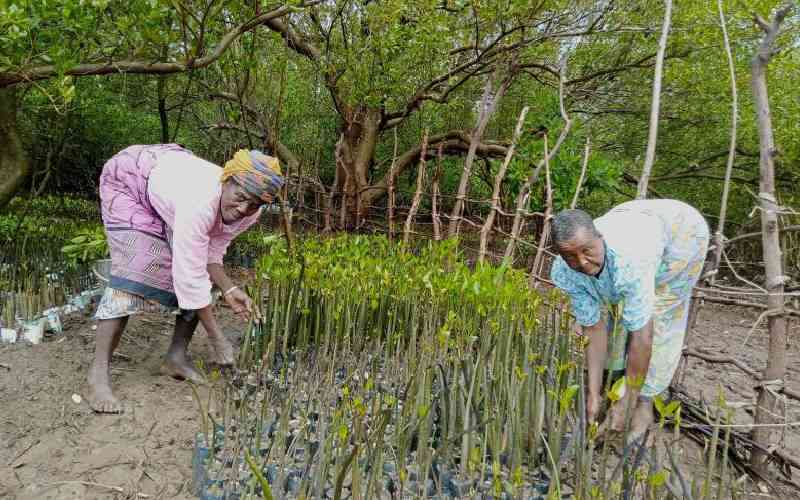By PETER ORENGO
The first global assessment of mangroves in over a decade reveals that rare and crucial mangrove forests continue to be lost at a rate three to four times higher than land-based forests.
About one-fifth of all mangroves are said to have been lost since 1980.
Although losses are slowing at 0.7 per cent a year, the authors warn any further destruction due to shrimp farming and coastal development would cause significant economic and ecological decline.
In Kenya, mangrove trees provide hard, rot-resistant timber and make some of the best charcoal in the world. The waters all around the forests foster some of the greatest productivity of fish and shellfish in any coastal waters.
"What’s more, mangrove forests help prevent erosion and mitigate natural hazards from cyclones to tsunamis. These are natural coastal defences whose importance will only grow as sea level rise becomes a reality around the world," said Dr Mark Spalding, lead author of the World Mangrove Atlas and senior marine scientist with The Nature Conservancy.
He adds mangrove forests are the ultimate illustration of why humans need nature. "There is good evidence mangroves even reduced the impact of the 2004 Indian Ocean tsunami in a number of locations," says Spalding. Economic assessments provide some of the most powerful arguments in favour of mangrove management, protection or restoration. Studies estimate mangroves generate between $2000-9000 (Sh160,000-720,000) per hectare annually, considerably more than alternative uses such as aquaculture, agriculture or insensitive tourism.
The new Atlas also underscores positive trends. Restoration efforts now cover some 400,000 hectares, as foresighted countries make the link between these coastal forests and economically important services- from flood defences and fish nurseries to carbon storage to combat climate change.
Achim Steiner, UN Under-Secretary General and Executive Director, United Nations Environment Programme (Unep), said: "The Economics of Ecosystems and Biodiversity, which is hosted by Unep, is bringing to the fore the multi-trillion dollar value of the world’s nature-based assets.
"Together, the science and the economics can drive policy shifts. Some 1,200 protected areas are now safeguarding around a quarter of remaining mangroves and many countries are now embarking on major restorations," he added.
What’s urgently needed is for all those in fields of forestry, fisheries and the environment to work together and communicate their worth, both to the public and to those with the capacity to make a difference," said Emmanuel Ze Meka, executive director of the International Tropical Timber Organisation, which provided the bulk of funding for the Atlas.
Shrimp aquaculture
The greatest drivers for mangrove forest loss are direct conversion to aquaculture, agriculture and urban land uses. Coastal zones are often densely populated and pressure for land intense. Where mangroves remain, they have often been degraded through over-harvesting.
Where vast tracts of mangroves have been cleared for shrimp aquaculture, fast profits often left a legacy of long-term debts and poverty, which are hard to reverse.
According to the Food and Agricultural Organisation, mangrove losses have been considerable and are continuing. Some 35,600 square kilometres were lost between 1980 and 2005.
Stay informed. Subscribe to our newsletter
While there are no accurate estimates of the original cover, there is a general consensus that it would have been over 200,000 square kilometres and that considerably more than 50,000 square kilometres or one-quarter of original mangrove cover has been lost as a result of human intervention.
 The Standard Group Plc is a
multi-media organization with investments in media platforms spanning newspaper
print operations, television, radio broadcasting, digital and online services. The
Standard Group is recognized as a leading multi-media house in Kenya with a key
influence in matters of national and international interest.
The Standard Group Plc is a
multi-media organization with investments in media platforms spanning newspaper
print operations, television, radio broadcasting, digital and online services. The
Standard Group is recognized as a leading multi-media house in Kenya with a key
influence in matters of national and international interest.
 The Standard Group Plc is a
multi-media organization with investments in media platforms spanning newspaper
print operations, television, radio broadcasting, digital and online services. The
Standard Group is recognized as a leading multi-media house in Kenya with a key
influence in matters of national and international interest.
The Standard Group Plc is a
multi-media organization with investments in media platforms spanning newspaper
print operations, television, radio broadcasting, digital and online services. The
Standard Group is recognized as a leading multi-media house in Kenya with a key
influence in matters of national and international interest.






